|
“Legal fight looms over sunken treasure”
January 7, 2003, BBC Science News, UK: “An international row is brewing between the Spanish Government and an American sea salvage company over what could be the most valuable shipwreck ever.
|
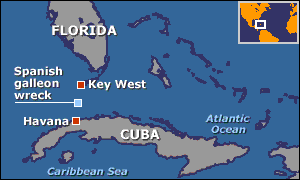
Copyright © 2003 BBC Science News
|
|
The salvage firm Sub Sea Research believes it has found what remains of the 64-cannon French ship, Notre Dame de Deliverance, which sank in a fierce storm 60 kilometres (40 miles) off Florida’s Key West in 1755.
The merchant vessel was chartered by Spain to carry treasures extracted from mines in Mexico, Peru and Colombia.
|
Its cargo of gold bullion, gems, coins and silver is worth an estimated $3bn.
Now Sub Sea Research has to answer the claims to the wreck by Spain and France.
[Full Story]
“Ancient Shipwreck Found in Black Sea”
January 16, 2003, Novinite, Bulgaria: “Researchers announced today their discovery of the shipwrecked remains of an ancient trading vessel over 2,300 years old that sank in the Black Sea off the coast of present-day Bulgaria.
The vessel dates to the 5th to 3rd century B.C., an era known to scholars as the classical period of ancient Greece-the time of Plato when Athens reached the height of power and Zeus was believed to rule the celestial firmament. The shipwreck is the oldest ever found in the Black Sea. It joins a relatively small handful of other known shipwrecks of the Greek period.
Members of a joint U.S.-Bulgarian research expedition discovered the wreck on August 1, 2002 in 275 feet (84 meters) of water off the eastern coast of Bulgaria. Using a three-person submersible vehicle launched from the 180-foot (55-meter) Bulgarian research ship Akademik, the team dove on a target previously identified by sonar on the last day of a 14-day expedition.”
[Full Story]
“Oldest Black Sea shipwreck found”
January 16, 2003, CNN, USA: “It’s the oldest shipwreck ever found in the Black Sea with relics from between the third and fifth centuries B.C. containing clues to the diet of ancient Greeks.
|
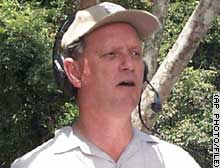
Copyright © January 2003, CNN
|
|
Explorer Bob Ballard – best known for finding the remains of the Titanic – announced the discovery this week in the United Staues.
A team headed by Ballard, working with the Bulgarian government, discovered the wreck in August.
|
‘This discovery provides historians with the first look at an actual wreck from a key era of trade in the Black Sea known previously only through written records,’ said Ballard, president of the Institute of Exploration at Mystic Aquarium in Connecticut and a National Geographic explorer-in-residence.
The wooden ship itself was gone, having rotted away through the millennia. But its scattered contents remained on the sea floor in testament to the ship’s sinking.
[Full Story]
“New research casts doubt over ‘Noah’s Flood'”
January 17, 2003, CCNet Post #6, England: “Some research backs the biblical story and some finds no evidence of the catastrophe.
Scientists are seriously challenging a recent, fascinating proposal that Noah’s epic story – setting sail with an ark jam-full of animal couples – was based on an actual catastrophic flood that suddenly filled the Black Sea 7,500 years ago, forcing people to flee.
In a detailed new look at the rocks, sediments, currents and seashells in and around the Black Sea, an international research team pooh-poohs the Noah flood idea, arguing that all the geologic, hydrologic and biologic signs are wrong.”
Little that the earth can tell us seems to fit the Noah story, they say. The new research takes direct aim at the work of two Columbia University geologists – William Ryan and Walter Pitman – whose proposal in 1997 ignited much new interest, and much new research, into Middle East history and geology.”
[Full Story]
“Precious metals mountain lies under Atlantic”
January 30, 2003, Ananova, UK: “A 500ft wide buried mountain of gold, silver and other valuable metals has been found two and a half miles beneath the middle of the Atlantic.
The mound, compared in size and shape to the Houston Astrodome in Texas, is said to be just one example of the riches to be found around volcanic vents on the sea floor.
Marine geologist Dr Peter Rona, from Rutgers State University in New Jersey, who made the discovery, said: ‘At least 50,000 years in the making, the mound is composed largely of combinations of the metals copper, iron, zinc, gold and silver. It was produced by jets of hot, metal-rich sea water.’.”
Dr Rona, who reviews research into sea floor resources in the journal Science, believes the ocean floor is teeming with valuable minerals and biomaterials.”
[Full Story]
“Discovery of pre-Harappan civilisation debunked”
January 30, 2003, The Times of India, India: “Claims of having discovered the world’s oldest human settlement in the Gulf of Cambay off the coast of Gujarat were just ‘bunkum’, renowned marine biologist S R Rao has said.
Such a ‘flippant and premature’ announcement to the media prior to publishing the data in a peer-reviewed journal ‘puts credibility of Indian science at stake’, Rao said here.
Union Minister for Science and Technology Murli Manohar Joshi had announced in May 2001 that the Department of Ocean Development (DOD) scientists had discovered a 9500 year-old buried township west of Hazira suggesting the human civilisation emerged from India.
The claim was made on the basis of acoustic images from sonar accidentally collected by a survey ship and carbon dating of a wood piece dredged out from the site.”
[Full Story]
“Sea monster with a toothache”
February 6, 2003, BBC Science News, UK: “As the young sea creature swam through the prehistoric sea, it probably felt a slight pain in its mouth – a toothache.
|
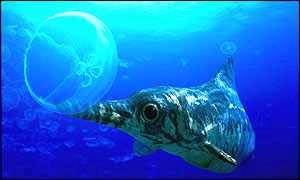
Copyright © 2003 BBC Science News
|
|
Things went from bad to worse when the juvenile ichthyosaur became sick or was attacked, and was left for dead on the seabed.
Nearly 110 million years later its fossilised skeleton has been found in Queensland, Australia, and that tiny tooth has become a vital clue for scientists.
|
Palaeontologist Ben Kear says the tooth decay is providing information about the creature’s eating habits.
:
“More often than not, it is the tiniest fossil or part of a fossil that yields some of the most interesting information. A monstrous bone might give you clues about the general shape of an animal, but to really get down to the details of its palaeobiology you have to take a more holistic approach.”
[Full Story]
“Traces of Persians’ lost fleet?”
February 11, 2003, Kathimerini, Greece: “Two 2,500-year-old bronze helmets caught in a fisherman’s nets off the western coast of Mt Athos may have belonged to soldiers in a Persian fleet shipwrecked in the area in 492 BC, during the first of the empire’s three great campaigns against Greece, archaeologists believe.
The two fifth-century-BC helmets, of the Greek Corinthian type, were found 110 meters deep, off the skete (monastic retreat) of Aghia Anna at the southern tip of Mt Athos by a fisherman from the village of Sykia, on the Sithonia peninsula west of the Holy Mountain.”
[Full Story]
“Portus Cosanus: Exploring a Roman port and fishery”
February 19, 2003, Archaeology Magazine, USA: “In the first half of the third century B.C., the Roman Republic was expanding. The conquest of the Etruscans, to the north, and of the Greeks, to the south, would give them control of the entire Italian peninsula. To solidify their control, the Romans established colonies along the Tyrrhenian coast of their new territories.
The port of Cosa, the earliest Roman port thus far known, was founded in 273 B.C. and was the reason for the establishment of the colony about 140 km north of Rome. The port, below the fortified hill town, enjoyed the protection of one of the few promontories along this predominantly sandy coastline and was the area’s only source of freshwater. Behind the harbor was a rich lagoon where excavations have revealed evidence of a large commercial fish farm.”
[Full Story]
“Six tsunamis have rolled into BOP say scientists”
March 11, 2003, New Zealand Herald, New Zealand: “Scientists investigating whether a tsunami could hit the Bay of Plenty believe six large tidal waves have swamped the area in the past 5000 years. Soil samples have been analysed at the start of a 3-year study on tsunamis commissioned by the Bay of Plenty and Waikato regional councils.
The results show at least six large tsunami have occurred since 2800BC – caused mainly by volcanic eruptions and earthquakes – but the size of each wave is not known.”
[Full Story]
“State’s ancient ports to be excavated”
March 25, 2003, Times of India, India: “If India ’s grappling with globalisation, the answers may be lying right here in Gujarat . A major project, to be undertaken by the National Institute of Oceanography (NIO) at Goa , plans to excavate ancient ports submerged along the Saurashtra coastline and reveal to the world the country’s maritime history and its strong presence in international trade centuries ago.
Startling artefacts like huge stone anchors used by ships, and various seals and shells, discovered during several land and underwater excavations in the Saurashtra region, have led scientists of NIO to plan an expedition to gather data on ancient ports that were once key players in the country’s economic prosperity.”
The project was conceptualised after an NIO team stumbled on a rare find — a cluster of about 20 to 30 ball-shaped anchors — during an underwater expedition off the coast of Somnath. About 120 to 125 different types of anchors have been found scattered along the Saurashtra coastline so far.”
“If anchors have been found near Somnath, there might be more such contemporary sites. These anchors should be at least 3000 years old as such structures have been found near Cyprus during that period,” says group leader of marine archaeology in NIO, Kamlesh Vora, who was in the city to attend a discussion on active tectonics in western India”
[Full Story]
“Sea Level Changes and Archaeology:
An Abstract of a dissertation”
March 26, 2003, Di-ve.com, Malta: “Modern archaeological thought has emphasised the need to evaluate past activities in terms of the available resources. This implies the need to construct past environments. Reconstructing the geography of the past requires a thorough understanding of geological and geomorphological processes together with an understanding of how past climates could have affected the landscape on a regional or localised scale.
The processes that form the earth are complex in nature and, more often than not, one process will trigger off a series of processes that will eventually result in dramatic changes in the earth?s surface topography. Coastlines are increasingly affected by changes in surface topography because any topographic change, both on the nearshore and offshore, will result in a compensatory change in coastal configuration in relation to the sea.
The Maltese Islands did not have the same geographical configuration in the past as that to which we are accustomed to in the present. Research in Mediterranean palaeogeography has proven that during the last glacial and subsequent early Holocene marine transgression the Maltese Islands looked different.
During the last glacial maximum (approximately 24,000-17,000y/a) the Maltese Islands formed part of mainland Europe via a landbridge that connected them to the Sicilian Hyblaean plateau. This allowed easy overland migration of fauna during the end of the Upper Pleistocene. After this short, yet significant period of maximum glaciation, the landbridge between Malta and Sicily was inundated and the Maltese Islands almost attained their present configuration by the Neolithic Period.”
[Full Story]
“Return to dramatic Atlantic vents”
April 17, 2003, BBC Science News, UK: “Scientists are returning to one of the most remarkable places on our planet: the so-called Lost City of Atlantis. An expedition from the University of Washington, US, is to use the submersible Alvin to take the first samples from the formation of 18-storey-high hydrothermal vents in the mid-Atlantic.
|
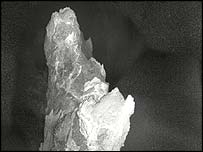
Copyright © 2003 BBC Science News
|
|
Formed by superheated water seeping out of the seafloor, the strange structures are made in a different way from other known hydrothermal vents.
They could be home to new forms of life and they could also shed new light on the origin of life on the Earth and on other worlds, too. The Lost City was discovered by accident in December 2000.
|
An automated sea-bed explorer stumbled across it near the end of a University of Washington, Scripps Institution of Oceanography and US National Science Foundation expedition to survey the mid-Atlantic.”
[Full Story]
“Massive Haul of Ancient Coins Fished out of SW China River”
April 19, 2003, People’s Daily, China: “Some five tons of ancient coins dating back to the Northern Song Dynasty (960-1127) had been retrieved from the Jialing River, a major tributary of the Yangtze at its upper reaches, in southwestern Chongqing municipality by Wednesday.
The coins, nearly covering all denominations used in the Northern Song Dynasty, have varying sizes, with their diameters varying from one to four centimeters.”
[Full Story]
“Florida’s Fossils: Look what the tide brought in”
April 20, 2003, The Japan Times, Japan: “Venice Beach, Fla., and the sun is hot and strong. Most tourists are simply lounging on the sand turning various shades of furious red or “Baywatch” bronze. A few are chucking Frisbees or checking out the babes.
Here and there, though, are individuals wandering around with their eyes fixed firmly on the ground, seemingly oblivious to their subtropical surroundings.
These guys aren’t here for suntans or babes. Like us, they’re here for the teeth of the biggest shark ever to have cruised the oceans; Carcharodon megaladon, known to aficionados as ‘Big Meg.’
Big Meg reached lengths of at least 24 meters, and may have become extinct as recently as 2 million years ago (or maybe not).”
[Full Story]
“Earth’s ancient sea water to be analysed”
April 25, 2003, The Guardian, UK: “British scientists are about to pioneer a way of investigating water droplets that have survived from seas where the Earth’s first microbes developed 3.8bn years ago.
“This will be the oldest sea water ever investigated. We should learn a lot by comparing it with much later samples,” said David Banks, of Leeds University, who is working on the project with colleagues in Denmark and South Africa.
A £1m laboratory opens in Leeds today to house the laser equipment which will be used to penetrate minute “wet” pockets in emerald and quartz crystals. Known as “fluid inclusions”, the microscopic remnants of the Archean age are possible clues as to how life developed on a hostile planet.”
[Full Story]
“Did KZN coelacanths all come from one mom?”
April 28, 2003, IOL/The Mercury, South Africa: “Underwater scientists exploring the ocean depths off South Africa have plucked a ‘missing link’ fish scale from one of several prehistoric coelacanths for genetic paternity tests.
The scale was removed from the rare fish at Sodwana, KwaZulu-Natal, using a tiny dart gun and a remote-controlled, robotic arm mounted on the German mini-submarine Jago earlier this week.
The Jago, owned by the Max Planck research institute, is part of an international expedition to learn more about the coelacanth population of Sodwana Bay.”
[Full Story]
“Atlantis Diaries – Leaving Port”
May 03, 2003, Astrobiology Magazine, USA: “The bizarre hydrothermal vent field discovered a little more than two years ago surprised scientists not only with vents that are the tallest ever seen – the one that’s 18 stories dwarfs most vents at other sites by at least 100 feet – but also because the fluids forming these vents are heated by seawater reacting with million-year-old mantle rocks, not by young volcanism.
The field is unlike any seen before, according to chief scientist Deborah Kelley, a University of Washington associate professor of oceanography, and co-chief scientist Jeff Karson, a Duke University professor of earth and ocean sciences. Both have visited fields of black-smoker hydrothermal vents that scientists have been studying since the 1970s.”
[Full Story]
“Atlantis Diary II – The First Dive to the Lost City”
May 09, 2003, Astrobiology Magazine, USA: “We awoke on our fifth day of transit to slightly rougher seas, but the sun was still out and the sky was blue. The weather made playing Ping-Pong (a favorite on the ship) a little more challenging.
At the science meeting today, Gavin introduced us to Alvin’s extensive video systems. We then heard from Tim Shank, an evolutionary biologist, about some of the macrofauna that we might see at Lost City.
It’s not as densely populated with animals like mid-ocean ridge hydrothermal vents often are, at least as far as we know. But there are many different kinds of corals and sponges, and even some amphipods, soft urchins, pink shrimp, nematodes, and polychaete worms.”
[Full Story]
“Atlantis Diary III – Exploring Alien Eco-Regions”
May 16, 2003, Astrobiology Magazine, USA: “The second dive of the expedition gave me appreciation for the scale of the landscape that one can only get by being there. Our dive began as they all do: with the systematic run through the safety checklists, climbing down into “the ball,” leaving the ship, and descending through the deepening blue into the quiet blackness of the deep sea. It’s a fantastic experience no matter how many times you do it.
Phil Forte was our highly capable and hard-working pilot, geologist Jeff Karson was on the port side, and I was tucked into the starboard side. We shifted around from time to time to share looks out of our three view ports.
We touched down at a depth of 870 meters, about 300 meters west of the known warm vents. We were on the side of a steep undersea mountain, where the terrain is extremely rugged and dramatic.”
[Full Story]
“Atlantis Diary IV – Eating Iron”
May 23, 2003, Astrobiology Magazine, USA: “It was just after lunch yesterday when I heard Deb Kelley exclaim ‘We sure are lucky people.’ We were maneuvering around an extinct carbonate spire, so I was too busy to ponder what her statement meant. She had said the same thing before, but each time I heard these words I was focused on something else.
For many of the scientists I meet on the Atlantis, the cruise is a welcome chance to leave the lab, travel to exotic locations, and perform long-thought-out fieldwork.
Thursday was one of those days. On days with scheduled dives, the Alvin group starts preparing the sub at around six o’clock in the morning. That means at about five thirty, I roll out of my bunk to the sound of my alarm’s annoying beep.”
[Full Story]
“Atlantis Will Be Found: Russian researchers have held the Second Congress of Atlantis Explorers in Moscow”
May 26, 2003, Pravda, Russia: “Has legendary Atlantis ever existed? Russian explorers and researchers have recently held a meeting in Moscow in order to discuss the material about the legendary continent and share their opinion with each other.
Alexander Voronin, the director of the Russian association for studying Atlantis’s problems stated at the meeting that Atlantis would be found. Alexander Voronin added that various findings in different parts of the planet proved the certainty of finding the lost continent.
Remains of the “big land” have been found in the water area of the Brazilian island of Sao Paulo; an undestroyed temple of thousands years old has been found in the sea not far from Europe. Voronin believes that such findings testify to the existence of a ‘central kingdom and numerous islands, on which ten Atlas brothers lived.’“
[Full Story]
“Atlantis Diary V – Hump Day”
May 30, 2003, Astrobiology Magazine, USA: “Every morning, I awaken with pleasure to see the launch of Alvin, hoping that it will bring back a lot of samples. Every afternoon I wait impatiently for its return to look at the samples collected from Lost City.
Alvin takes several kinds of samples: water samples, biologic samples, and rock samples. My interest is in the rock samples. My specialty on this cruise is the petrology and the geochemistry, and my job is to describe the rocks collected from the Lost City after each dive.
I cut them in order to describe them in detail and to learn about their history: where they come from, the conditions of formation, and alterations they display. Additional analyses will be performed in the laboratory on land (bulk, mineralogical, and isotopic compositions).”
[Full Story]
“Susan Langley – Underwater Archaeologist – Interview”
June 01, 2003, The Washington Post, USA: “I remember seeing a National Geographic cover, a diver coming out of a sinkhole off the Yucatan. The diver was holding an intact urn, the sediment curling off his wrist, off the urn.
There’s a great advantage to underwater archaeology. There’s a lot more organic preservation than you can see on the land. You find fabric, clothing, human tissue, wooden buttons, basketry, food remains. It’s like playing detective.
I look at the evidence, try to understand it, what may have occurred. Sometimes there is a time capsule, a little Pompeii. At one site, a coffin floated up and in the man’s pocket there was an 1869 coin.”
[Full Story]
“New Centre for Maritime Archaeology founded at Oxford”
June 02, 2003, University of Oxford, England: “Oxford University researchers will be able to get first-hand experience working on some of the most important underwater excavations being carried out today, following the creation of the Oxford Centre for Maritime Archaeology.
An agreement between the University, the Hilti Foundation, and the Institut Européen d’Archéologie Sous-Marine (IEASM) will be signed today, following a lecture in Oxford by French Maritime Archaeologist Franck Goddio, to establish the new Centre within the School of Archaeology.
Throughout time the sea has been a crucial factor in linking disparate communities together. Maritime Archaeology embraces a range of subject areas – including ancient technology, navigation, coastal geomorphology and mythology, as well as cultural archaeology and history – to understand more about maritime trade, economies, and the people who undertook sea-going adventures.”
[Full Story]
“Mammoth herds ‘roamed fertile Bering Strait in Ice Age'”
June 04, 2003, Ananova, UK: “Huge herds of mammoth, wild horses and bison once roamed the land bridge between North America and Siberia, new evidence suggests.
Plant fossils have shown that 24,000 years ago, during the last Ice Age, dry grassland covered much of region.
The vegetation would have allowed large populations of mammals to survive all year round on the now-submerged landmass known as Beringia or the Bering Strait.”
[Full Story]
“Atlantis Diary VI – Portal on the Past”
June 06, 2003, Astrobiology Magazine, USA: “While the Atlantis sits on the surface all day, I often wonder how many people have sailed, steamed, or cruised over this very spot, or perhaps even stared into the deep without any notion of the remarkable ecosystem that lies beneath the water.
Columbus? Conquistadors? Pirates? Marines, sailing for the shores of Tripoli? GIs headed to Africa and Normandy? We’re certainly not the first ones here: yesterday Alvin spotted a drink bottle on the seafloor beneath Lost City!
What would the ocean floor have looked like four billion years ago? Many geologists think it might have looked a lot like what we’re seeing now at Lost City (with one caveat: the four-billion-year-old bottle hypothesis remains controversial). Today ocean crust is made mostly of a rock type called basalt. But four billion years ago, it may have been mostly peridotite – just like at Lost City.”
[Full Story]
“Atlantis Diary VII – Poseidon’s Excellent Adventure”
June 13, 2003, Astrobiology Magazine, USA: “I had an exciting day yesterday. Every day of a research cruise is interesting, but yesterday was particularly special because I had my first dive in Alvin.
We began the dive by exploring a topographic high point called “The Hump.” This feature is to the southeast of Lost City. Pat landed Alvin directly over The Hump, and right away we saw little carbonate spires.
He used a temperature probe to determine if the spires were actively venting, but they weren’t very hot. Then he used the manipulator arm to grab the top of the spire and break it off, obtaining our first sample.”
[Full Story]
“Atlantis Diary VIII – Science Basket”
June 21, 2003, Astrobiology Magazine, USA: “Taking them to the bottom of the ocean isn’t enough; the scientists also want to bring the seafloor back with us. That’s not an unreasonable request when you consider that Lost City was discovered in December of 2000, and it has taken them this long to get back to it.
Debbie and Jeff (the chief scientists) had one dive to look at Lost City, which is about 400 square meters, on a cruise dedicated to characterizing the Atlantis massif, an area of about 400 square miles. They were able to collect a few samples – really just enough to prove they needed more.
So for the last two years they have been wondering what kind of rock lies under the white carbonate, and what is the chemistry of the fluids that build the spires. That’s where the Alvin comes in. We take them down, and we haul it all up.”
[Full Story]
“Atlantis Diary IX – Rescue”
June 28, 2003, Astrobiology Magazine, USA: “Dive 3,881 today was special, not only because this was our farewell dive in the Lost City Hydrothermal Field, but, more importantly, because it marked the 500th dive that Expedition Leader Pat Hickey has made to the seafloor in Alvin.
Final dives are commonly some of the most difficult because the main goals include many diverse “chores” that have somehow accumulated at the end of the program.
This last dive was no different. There was a long wish list of things that people wanted: explorations of new venting sites, rocks from specific areas, suites of fluids, biology and carbonate samples from multiple places, mosaics of entire structures to obtain full-view images, and traverses around the outer edges of the huge structure Poseidon.”
[Full Story]
|
|
To understand why this News Page is sometimes late here is some information about Fibromyalgia
if you would like to support our marine archaeology research
The Morien Institute
Research Projects
please send us a book

from our Wish List
…
exclusive
…
October 2002
Morien Institute
illustrated interview with
Professor Masaaki Kimura
of the University of the Ruykyus,
Okinawa, Japan, regarding
the discovery of:
“Megalithic structures found underwater off the coast of
Yonaguni-jima, Japan”
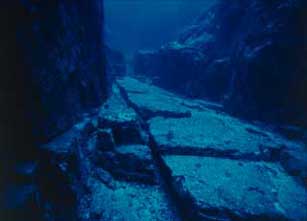
…
exclusive
…
June 2002
Morien Institute
illustrated interview with
Dr Paul Weinzweig
of Advanced Digital Communications,
Havana, Cuba, regarding
the discovery of:
“Megalithic urban ruins discovered off the coast of Cuba”
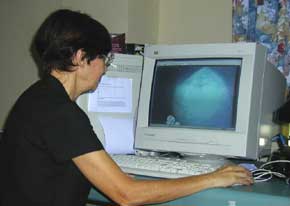
“Atlantis of the West: The Case For Britain’s Drowned Megalithic Civilization”
by Paul Dunbavin
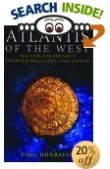
EU English Edition
“Do Welsh legends of lost cities beneath the sea match Plato’s descriptions of the island civilization of Atlantis? Do Irish myths of a golden age when the eastern Irish Sea was a flowery plain describe the same place Herodotus said disappeared beneath the waves during a single day and night of geological upheaval millennia before Ancient Greece?
Author and researcher Paul Dunbavin has embarked on a multidisciplinary investigation into how science could explain such a catastrophe and how modern archaeological findings point to a possible location for lost Atlantis. This book theorizes that the Middle Neolithic period around 5,000 years ago was a time of dramatic climate and sea-level changes all around the world.
From an up-to-date scientific perspective, Dunbavin distills an array of significant geological theories and then examines the archaeological and mythological record-which together leads to a lost land thousands of years ago in the Irish Sea that was still mentioned in ancient Welsh histories recorded in the 6th century.”
“Eden in the East: The Drowned Continent of Southeast Asia”
by Stephen Oppenheimer

EU English Edition
“A book that completetly changes the established and conventional view of prehistory by relocating the Lost Eden – the world’s 1st civilization – to SouthEast Asia. At the end of the Ice Age, SouthEast Asia formed a continent twice the size of India, which included Indochina, Malaysia, Indonesia and Borneo.
The South China Sea, the Gulf of Thailand and the Java sea, which were all dry, formed the connecting parts of the continent. Geologically, this half sunken continent is the Shunda shelf or Sundaland.
He produces evidence from ethnography, archaeology, oceanography, from creation stories, myths and sagas and from linguistics and DNA analysis, to argue that this founder civilization was destroyed by a catastrophic flood, caused by a rapid rise in the sea level at the end of the last ice age.”
“Discovery of Atlantis: Startling New Evidence and the Case for Cyprus”
by Robert Sarmast
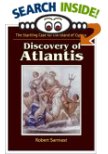
EU English Edition
“Plato provided 53 physical clues in his famous dialogue Critias–the original account of the story of Atlantis that is the sole basis of all Atlantis research.
Discovery of Atlantis proves that the island of Cyprus and the underwater landscape just south of Cyprus is a perfect match with 51 of these clues. Exclusive 3D bathymetric maps based on new scientific data show for the first time a stretch of sunken land off of Cyprus.
The general layout of the landscape of Atlantis as described by Plato is easily discernible on this underwater landmass, as well as the precise location of its capital–Atlantis City. This robust empirical data is joined with other original findings based on mythological analysis and historical research, making the case for Cyprus increasingly obvious.”
“Underworld: The Mysterious Origins of Civilization”
by Graham Hancock
&
Santha Faiia
(Photographer)

EU English Edition
“From Graham Hancock, bestselling author of Fingerprints of the Gods, comes a mesmerizing book that takes us on a captivating underwater voyage to find the ruins of a lost civilization that’s been hidden for thousands of years beneath the world’s oceans.
While Graham Hancock is no stranger to stirring up heated controversy among scientific experts, his books and television documentaries have intrigued millions of people around the world and influenced many to rethink their views about the origins of human civilization. Now he returns with an explosive new work of archaeological detection.
In Underworld, Hancock continues his remarkable quest underwater, where, according to almost a thousand ancient myths from every part of the globe, the ruins of a lost civilization, obliterated in a universal flood, are to be found.”
“Atlantis and Earth’s Shifting Crust”

VHS NTSC version
(USA and Canada)
“Searching for Lost Worlds: Atlantis”

VHS NTSC version
(USA and Canada)
“Quest for the Lost Civilisation: Boxed Set”

VHS NTSC version
(USA and Canada)
VHS UK PAL version
(UK and Europe)
“The Atlantis Blueprint: Unlocking the Ancient Mysteries of a Long-Lost Civilization”
by Colin Wilson & Rand Flem-Ath

EU English Edition
“The Great Pyramid. Stonehenge. Machu Picchu. For centuries, these and other sacred sites have inspired wonder among those who ponder their origins.
Conventional science tells us they were constructed by local peoples working with the primitive tools of a fledgling civilization. Who could have built these elaborate monuments? How did they do it? And what were their incomprehensible efforts and sacrifices designed to accomplish? Now comes a revolutionary theory that connects these mysteries to reveal a hidden global pattern–the ancient work of an advanced civilization whose warnings of planetary cataclysm now reverberate across one hundred millennia.
International bestselling author Colin Wilson and Canadian researcher Rand Flem-Ath join forces to share startling evidence of a fiercely intelligent society dating back as much as 100,000 years–one that sailed the oceans of the world, building monuments to preserve and communicate its remarkable wisdom.”
“Submerged Cultural Resource Management: Preserving and Interpreting Our Sunken
Maritime Heritage”
James D. Spirek (Editor),
Della A. Scott-Ireton (Editor)
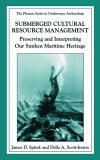
EU English Edition
“This vital book is a collection on the various ways archaeologists and resource managers have devised to make available and interpret submerged cultural resources for the public, such as underwater archaeological preserves, shipwreck trails, and land-based interpretive media and literature.
The concept of preserves, parks, and trails has proven to be an effective and popular method of public education and heritage tourism with the end result being a greater public understanding of the value of preserving and protecting shipwrecks, and other submerged cultural resources, for the future.
Within each contribution, the authors focus on: legislation; economic benefits; interpretation methods; problems and successes; future directions regarding their preserve, park, or trail programs.
Various approaches to the concept have been explored and this book is an effort to make available our experiences in the management of submerged cultural resources for the public. This volume is an invaluable resource to underwater archaeologists, cultural and heritage resource managers, museum and heritage educators and those studying these professions.”
|















